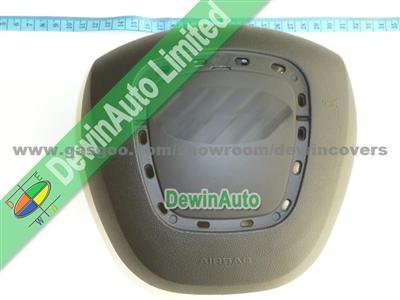Wheel Cover Airbag Cover For Audi A4
- Application: VW AUDI A4 B8 2010-
- Market Type:After Market
- FOB Price: USD 5
- Payment Terms: T/T
- Samples: Free
- Minimum Order: 1Pair/Pairs
Quick Details
-
Material:
Rubber
-
Color:
Black
-
Size:
6inch
-
G.W:
6g
- Place of Origin:
CHINA
- Samples:
Free
- Delivery Time:
99
- Packing:
Normally
- Delivery Port:
Shanghai
- Max. Production Capacity:
999
- Export Ratio:
21% - 30%
- OE Experience:
No
Product Name:Wheel Cover Airbag Cover For Audi A4
Wheel Cover Airbag Cover For Audi A4
Application
VW AUDI A4 B8 2010-
Product Description:
An air bag is an inflatable cushion designed to protect automobile occupants from serious injury in the case of a collision. The air bag is part of an inflatable restraint system, also known as an air cushion restraint system (ACRS) or an air bag supplemental restraint system (SRS), because the air bag is designed to supplement the protection offered by seat belts. Seat belts are still needed to hold the occupant securely in place, especially in side impacts, rear impacts, and rollovers. Upon detecting a collision, air bags inflate instantly to cushion the exposed occupant with a big gas-filled pillow.
A typical air bag system consists of an air bag module (containing an inflator or gas generator and an air bag), crash sensors, a diagnostic monitoring unit, a steering wheel connecting coil, and an indicator lamp. These components are all interconnected by a wiring harness and powered by the vehicle's battery. Air bag systems hold a reserve charge after the ignition has been turned off or after the battery has been disconnected. Depending on the model, the backup power supply lasts between one second and ten minutes. Since components vital to the system's operation might sit dormant for years, the air bag circuitry performs an internal "self-test" during each startup, usually indicated by a light on the instrument panel that glows briefly at each startup.
The crash sensors are designed to prevent the air bag from inflating when the car goes over a bump or a pothole, or in the case of a minor collision. The inflator fits into a module consisting of a woven nylon bag and a break-away plastic horn pad cover. The module, in turn, fits into the steering wheel for driver's-side applications and above the glove compartment for front passenger applications.
In a frontal collision equivalent to hitting a solid barrier at nine miles per hour (14.48 kilometers per hour), the crash sensors located in the front of the car detect the sudden deceleration and send an electrical signal activating an initiator (sometimes called an igniter or squib). Like a light bulb, an initiator contains a thin wire that heats up and penetrates the propellant chamber. This causes the solid chemical propellant, principally sodium azide, sealed inside the inflator to undergo a rapid chemical reaction (commonly referred to as a pyrotechnic chain). This controlled reaction produces harmless nitrogen gas that fills the air bag. During deployment the expanding nitrogen gas undergoes a process that reduces the temperature and removes most of the combustion residue or ash.
The expanding nitrogen gas inflates the nylon bag in less than one-twentieth (1/20) of a second, splitting open its plastic module cover and inflating in front of the occupant. As the occupant contacts the bag, the nitrogen gas is vented through openings in the back of the bag. The bag is fully inflated for only one-tenth (1/10) of a second and is nearly deflated by three-tenths (3/10) of a second after impact. Talcum powder or corn starch is used to line the inside of the air bag and is released from the air bag as it is opened.
Supplier Details
You May Like:
-
Airbag Cover For Ford
Application: FORD
-
Original SRS Cover Airbag Cover Hyundai
Application: Hyundai
OEM No: Hyundai
-
Original SRS Cover Airbag Cover BMW
Application: BMW
-
22914039 20817720 Air Bag Clockspring For Chevrole ...
Application: Chevrolet
OEM No: 2081772 ...
-
Great Wall Parts COMBINATION SW ASSY(AIR BAG) 3774 ...
Application: Haval
OEM No: 3774100 ...
-
Sinotruk Howo Spare Parts Air Valve 12JS160T-17030 ...
Application: Sinotruk Howo
OEM No: 12JS160 ...
-
Higer Bus SRI1885 Air Cell 1R2A-445-280
Application: Higer bus
OEM No: 1R2A-44 ...
-
Best Quality Geely Parts Driver Air Bag 1017009517 ...
Application: Geely
OEM No: 1017009 ...
-
DAF Air Preparation Unit 1443155,1443153,1374293,1 ...
Application: DAF
OEM No: 1443155 ...
Related Product Tags:
Air Bag , Air Bags , Car Air Bag , Good Air Bag , Bag and Air Bag , Wire Harness Air Bag , Harness Air Bag , santa air bag , santa air bag buick , santa air bag fiat , santa air bag honda , repair air bag , air cylinder , honda city airbag , bora airbag , main airbag , passenger airbag , opel airbagPlease send us Your Search Requirement, or you can Post a Buying Lead,
suppliers may contact you actively.









